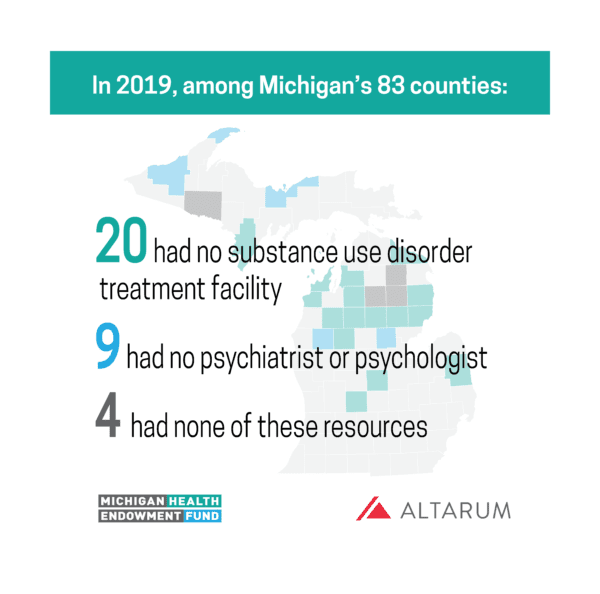
Michigan has made some progress in treating mental health and substance use disorders—but we still have a long way to go.
That’s one major conclusion of the Health Fund’s latest Behavioral Health Access Study, released in December. Below, read our key takeaways and hear how we’re planning to share stories from the study throughout the year.
BACKGROUND
In 2019, the Health Fund partnered with health researchers at Altarum to produce a detailed study on access to behavioral health care for people across Michigan.
Using a combination of sources including surveys, data from government agencies and claims information from Medicaid, Medicare and private insurance, the report provided new insights on the utilization of care for mental illness and substance use disorders, while highlighting that many Michigan residents face barriers to accessing the help they need.
In 2022, we revisited our partnership with Altarum to commission a new edition of the study. The resulting report provides an updated analysis using data from 2019, providing a comprehensive examination of behavioral health care access in our state just prior to the COVID-19 pandemic.
KEY FINDINGS
The number of Michiganders experiencing a mental illness or substance use disorder rose from 2016 to 2019, but access to care also increased.
The number of people reporting a mental illness rose from 1.76 million in 2016 to nearly 2 million in 2019. Of the Michiganders who reported a mental illness in 2019, 68% received treatment, compared to 62% in 2016. This is a significant improvement in just a few years. In other words: we’re treating more people for mental health, and the need for treatment also continued to grow.
More than two thirds of people experiencing a SUD go untreated.
The number of people receiving SUD treatment in 2019 increased slightly from 2016, up from 128,000 to 160,000. As a result, the percentage of people with an SUD who accessed treatment increased from 20% to 28%.
So while there was progress, a significant majority of people experiencing a SUD continued to go untreated.

Some Michigan counties lacked care from a psychology/psychiatrist, substance use treatment facility, or both.
Geography matters.
The community you live in makes a major difference in determining whether you have access to behavioral health care.
In metropolitan areas where access is the highest, up to 80% of people who needed treatment for a mental illness were able to get it. That figure was as low as 54% in areas with the lowest rates of access.
Study of subpopulations reveals unique insights.
A new feature of the 2022 report is a focused examination of specific populations who may face unique circumstances, needs, and barriers in accessing behavioral health care. For example:
- The study examined behavioral health utilization among women who are pregnant or recently gave birth, determining that 28% of pregnant women on Medicaid and 26% on private insurance received treatment for any mental illness.
- The study also found that 38% of children in the foster care system received treatment for a mental illness, while providing a detailed breakdown of the conditions that required care.
MORE TO COME
We’ll dive into these numbers and what they tell us about care for specific groups of people throughout 2023, so stay tuned.
This study is more than an exercise. We use it to inform our understanding of behavioral health care in Michigan and make decisions about our investments—and we encourage others working in this space to do the same. We also plan to repeat the study on a regular cycle, providing updated information and insights over the long term.
Learn more now by reading the full report or watching a recording of our recent webinar about the study with experts from Altrarum and the Health Fund.
